This was published 10 years ago
Cornwall, England: In the steps of saints
Rosamund Burton tackles Cornwall's St Michaels Way pilgrimage route.
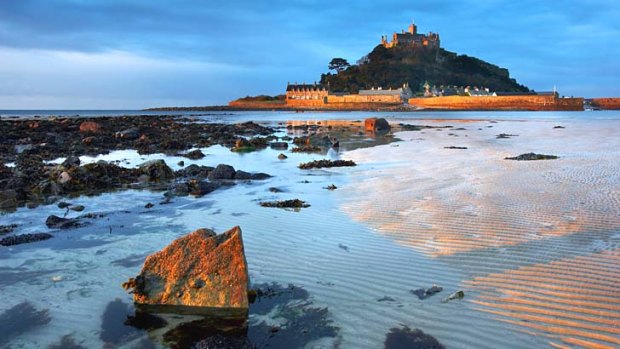
Way out west: St Michaels Mount.Credit: Alamy
High grass and hogweed surround the lichen-covered crosses in the overgrown graveyard. The stone walls of the little church resound with a slow melody, as the organist does his Monday morning practice. Built in the 12th century St Uny Church at Lelant is the start of St Michaels Way, a 16-kilometre long pilgrim route to St Michaels Mount, the tidal island near Penzance.
Having cycled along the Camino de Santiago in Spain, I am intrigued by this pilgrim route cutting across the western tip of Cornwall. For hundreds of years St Michaels Way was used by Irish and Welsh pilgrims travelling to St James' Cathedral at Santiago de Compostela in North West Spain. Rather than sailing around Land's End, notorious for its treacherous waters, the pilgrims left their boats in the Hayle Estuary, below the church, and walked across the peninsula. The way was almost forgotten until 10 years ago when it was developed and officially opened in 2004. It is the only footpath in Britain which is part of a designated European Cultural Route.
Initially, the way follows the coastal path towards St Ives. Little pale blue forget-me-nots grow on the cliffs intermingled with herb robert and purple orchids, and below the surf breaks on to long sandy beaches. It is a still day interrupted only by an occasional four-carriage local train rattling along the track to or from St Ives.
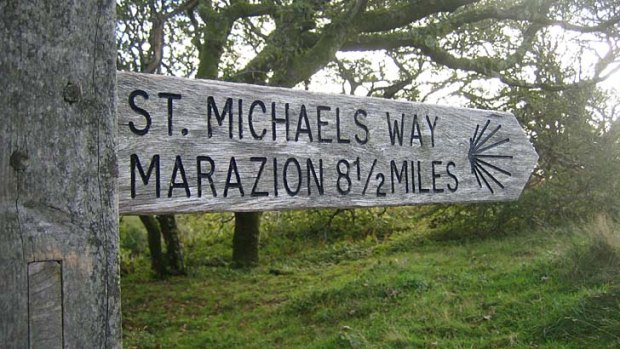
St Michaels way.
I pass the majestic Carbis Bay Hotel with its glass conservatory and deck chairs optimistically set out on the front lawn despite the cold nip in the air.
I've seen several people carrying knapsacks and assume they must also be walking St Michael's Way, but at the wooden sign with its scallop shell emblem (the symbol of the St James pilgrim) I'm the only one to follow it and turn inland.
Beyond Knill's Monument - the 16-metre high granite steeple, built in the 18th century in memory of John Knill, the collector of Customs - despite the path being clearly signposted, I get lost. I'm wishing I had invested in the Ordnance Survey map marking St Michaels Way when an elderly woman directs me back on track, and I reach Trencrom Hill. This was a Neolithic fort, although legend says the piles of granite boulders scattering the hill top are because the giant of Trencrom and the giant of St Michaels Mount used to play a stone-throwing game up here. Looking back to the north is Godrevy Lighthouse, on which Virginia Woolf based her book, The Lighthouse. Ahead of me rising up from the sea is the mystical St Michaels Mount.
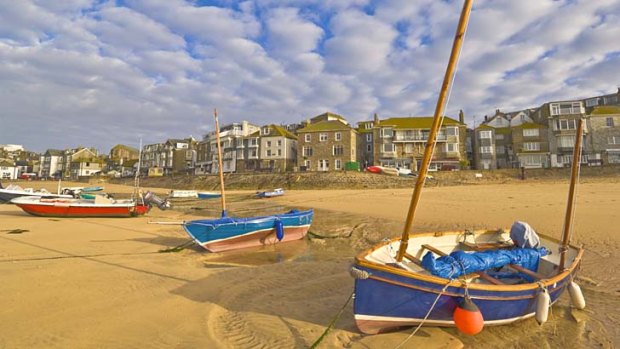
Sands of ages: Boats await the tide at St Ives.Credit: Getty Images
St Michaels Way is thought to date as far back as 10,000BC and at the hamlet of Ninnes Bridge there are three large standing stones beside the path indicating it is a pre-Christian route.
Sprinting across a field frantically searching for a gate, while pursued by a herd of bullocks, I have another momentary yearning for a map. But that is quickly superseded by the sheer joy of walking across open fields. A cock pheasant flies up out of the grass just ahead of me, and a pair of rabbits hop into a cluster of purple headed foxgloves.
High banks dripping with deep red fuchsias line either side of the narrow path, before it crosses a stream and winds through a wood up to Ludgvan church. Above the porch is a stone carving of a pilgrim holding a staff. This was a meeting point for pilgrims before making the final stage of their journey, as crossing the Marazion Marshes could be hazardous. Today, wooden boardwalks stretching over the marshland make it an easy stroll.
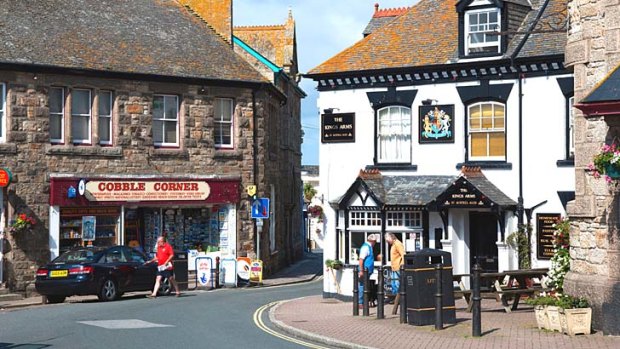
The old village of Marazion.Credit: Alamy
A pair of white swans glide quietly past a grey heron standing motionless among the reeds and the yellow flag irises.
The path ends at the beach and straight ahead is St Michael's Mount. It's 6pm and high tide, and boat trips from Marazion to the island have finished for the day. So I indulge in a large vanilla Cornish ice-cream and plan to make the final stage of my journey tomorrow.
By midmorning the tide is low and I join the trail of visitors walking along the stone causeway to the Mount. The keels of colourful wooden boats rest on the sand in the little stone-walled harbour. The island used to be a major port and it was from here that pilgrims travelled by boat to Europe.
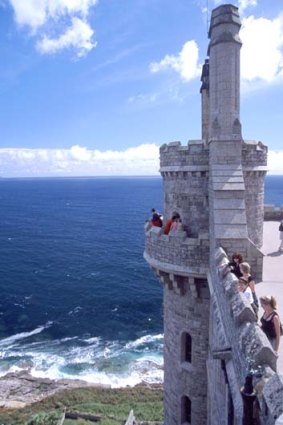
The castle on St Michaels Mount.Credit: Alamy
Since 1954 St Michael's Mount has been run by the National Trust, but it is still home to the Aubyn family, who have lived here for 350 years. It was a priory and pilgrim destination before that, and a recent archaeological discovery dates back to the Bronze Age.
My first stop is the Island Cafe, where the till has broken down and a woman is calmly serving a long line of people wanting lunch. All the staff on the island are extremely friendly and helpful, and I notice the guides doing their best to answer all visitors' questions, however obscure.
Having eaten a delicious homemade Cornish pasty, and wandered through the beautiful terraced gardens, I climb the mediaeval Pilgrim Steps to the castle. There is a sign beside the cobbled path: The Giant's Heart. According to legend, a giant called Cormoran, presumably the same one who played the stone-throwing game with the Trencrom giant, lived here. He used to steal poultry and livestock from the mainland, as well as an occasional child to eat, before he was killed by an ingenious local boy called Jack. The Giant's Heart turns out to be a tiny dark heart-shaped stone in among the cobbles.
Beyond the stone ramparts and rows of cannons on the western side of the castle stands a granite stone pillar. This is where St Michael is believed to have appeared to a group of fishermen in AD495, and why the Mount became a place of pilgrimage from the 6th century. The mystery of the Mount deepens when I am later told by Peter Hamilton, the visitor reception manager, that St Michael's stone is also the spot on which four major ley lines converge.
In 1135, a priory was built on the Mount as it had come into the possession of the Benedictine priory at Mont-St-Michel in Normandy. Inside the castle the evidence of the 12th century priory is apparent. The splendid Chevy Chase room,- named from the medieval ballad, not the American actor - with its impressive hunting scene frieze, would originally have been the monks' refectory.
The Church of St Michael and All Angels is mostly 14th century. Its treasures including a 600-year-old lantern cross carved from Cornish stone and a stained-glass window depicting the virgin and child with St Michael's Mount in the background and the St Aubyn family dog in the foreground.
I sit on one of wooden benches and realise what a gift it's been to follow in the footsteps of all the pilgrims who came here over the centuries.
FIVE MORE THINGS TO DO IN WEST CORNWALL
TATE ST IVES, which reopens on May 17 after renovations, has an impressive collection of modern and contemporary art. It also manages the Barbara Hepworth Museum and Sculpture Garden. See tate.org.uk/visit/tate-st-ives
GEEVOR TIN MINE, with its museum and many old buildings, is the place to learn about Cornwall's rich mining history. Visitors can go into the 19th century mine. See geevor.com
THE MINACK THEATRE offers the opportunity to see a show under the stars in the amphitheatre carved out of rock overlooking Porthcurno Bay. The open air theatre and its tropical gardens are also open to visitors during the day. See minack.com
LAND'S END is the most south-westerly point of mainland Britain, a famous landmark and natural beauty spot. Entrance is free. See landsend-landmark.co.uk
THE JUBILEE POOL in Penzance, currently closed for renovations, is Britain's largest surviving seawater lido. Measuring more than 100 metres, this 1930s art deco lido offers views of St Michael's Mount and the fishing village of Newlyn. See tempusleisure.org.uk
TRIP NOTES
GETTING THERE
Trains run from London Paddington to Penzance.
An off-peak return ticket costs £127 ($230). See firstgreatwestern.co.uk or thetrainline.com.
From Penzance railway station, buses run to Lelant, Marazion and St Ives. See westerngreyhound.com
SEE+DO
St Michael’s Mount castle is open from March 30 to November 2, Sunday to Friday (closed on Saturdays) from 10.30am to 5pm.
The gardens are open from April 14 to June 27, Monday to Friday, and July 3 to September 26, on Thursdays and Fridays only.
MORE INFORMATION
Sign up for the Traveller Deals newsletter
Get exclusive travel deals delivered straight to your inbox. Sign up now.